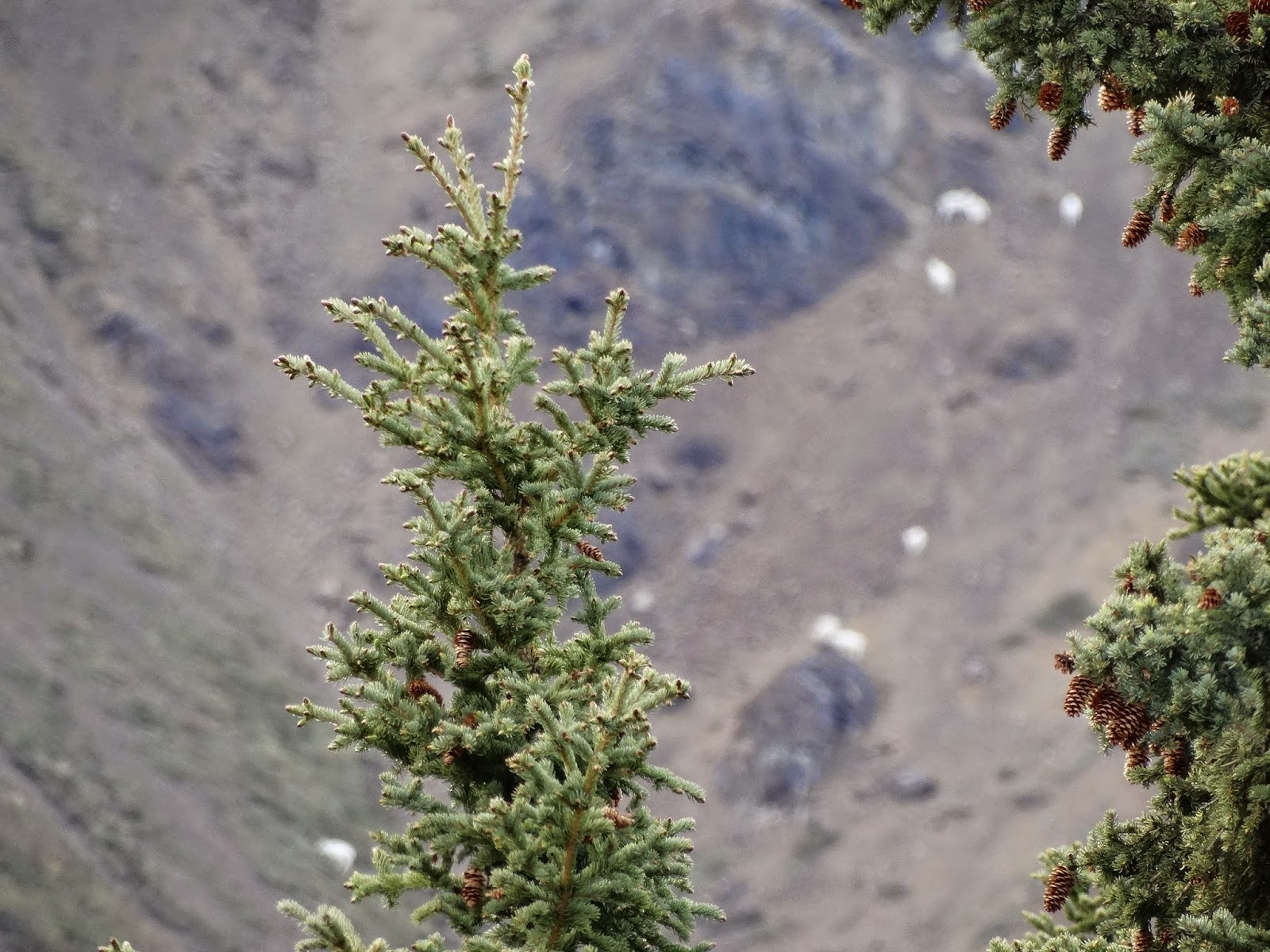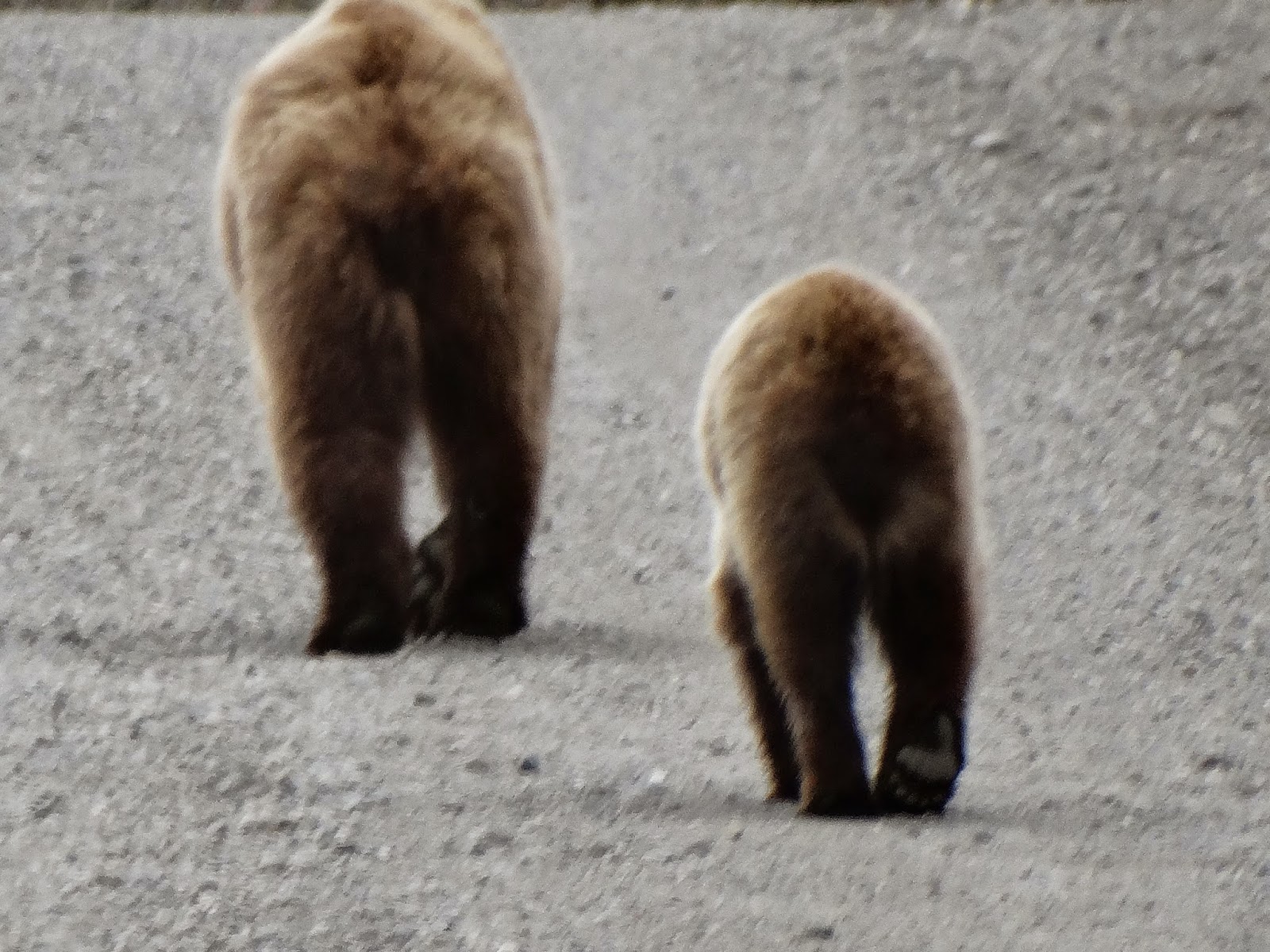 |
| "Dall sheep most often appear from the road as white dots moving on mountain ridges." |
 |
| "Dall sheep favor wind-blown ridges and steep cliff faces, where they can roam beyond the easy reach of wolves." |
 |
| "The wild sheep rely on keen eyesight to keep track of predators." |
 |
| "Denali is now home to more than 2,500 Dall sheep." |
 |
| "They prefer the habitat of alpine ridges, meadows and steep, rugged slopes." |
 |
| Their weight ranges between 125 to 200 pounds. |
 |
| "Denali is the only national park patrolled in winter by dog sled, a tradition continued from the Sheldon and Karstens days. The dog kennels, open to the public, are located near the park entrance." |
 |
Igloo Creek Campground is at mile 35 on the Park Road. It offers 7 sites, making it the smallest in Denali (along with Sanctuary River Campground, which also has 7 sites). Igloo is tent only.
|
 |
| "Dall sheep grow to between 3 and 3.5 feet at their shoulders." |
 |
| Dall sheep live 11 to 14 years. |
 |
| "Dall sheep mate November to December at 3 years of age. The gestation period is 6 months." |
 |
| "New life bursts onto the landscape with urgency in late May as long daylight hours bathe Denali with warmer temperatures." |
 |
| "One lamb is born May--June, twins are rare." |
 |
| The male is a ram. The female is an ewe. The offspring is a lamb. A group of Dall sheep is a band. "Rams establish dominance through head-butting." |
 |
| "In midwinter, the sun will stay hidden for all but four hours each day, and temperatures may drop to forty or fifty degrees below zero." |
 |
| Bear back ends are better than no bears at all. Right? |
 |
| Look at them, just ambling along with nary a care in the world. |
 |
| A mama bear and her two cubs make their way along the same road we're traveling. We stop and let them go about their day. |
 |
| A male Grizzly Bear is a boar. The female is a sow and the offspring are cubs. |
 |
| Check out that bear paw. I love it. "Bears are omnivorous. 80% of their food is roots, grasses and berries. 20% consists of ground squirrel, moose and caribou calves, rodents and carrion." |
 |
| Sorry for the repetition but how many chances will I get to photograph grizzly bears? A male will grow to between 300 to 500 pounds, maximum 650 pounds. Females grow to between 200 and 400 pounds. |
 |
| The maximum height is 6 to 7 feet standing, 3.5 to 4 feet at the shoulders. |
 |
| The bus ahead had stopped. Its passengers observe the bears as we did. We were asked to keep our voices down so as not to disturb the family of bears. |
 |
| "Grizzly bears live to be in their 20s; some have been known to reach age 30. |
 |
| Take a long, hard look at this view. Capturing any sight other than the rear ends was a rarity during this bear sighting. |
 |
| Look at those front paws with the claws. Maybe I should be grateful they're walking away from us! |
 |
| "A digging bear may be looking for roots or a ground squirrel." |
 |
| Hey, wait for me! |
 |
| "Denali is home to more than 160 species of birds, 37 species of mammals and hundreds of species of plants." |
 |
| "Large mammals often remain hidden in the intricate tapestry of landscape. Populations can fluctuate dramatically." |
 |
| "Still, Denali is now home to more than 1,900 moose, 1,700 caribou, 2,500 Dall sheep, 300 to 350 grizzly bears and 100 wolves live or roam in Denali National Park and Preserve." |
 |
| Uh oh... |
 |
| What a beautiful sight! |
 |
| There I go again, getting overly excited. |
 |
| These grizzlies were always on the move. Whether walking the park road or foraging for food, they were mesmerizing to observe. |
 |
| The Tundra Wilderness Tour began at the upper right corner of this map. We have reached Sable Pass on the left side of the map. |
 |
| So much to see and be amazed by. |
 |
| A bus looks insignificant in this landscape. The people inside seem trivial indeed. |































4 comments:
I was shocked to read that Dall Sheep weigh from 120 to 200 pounds. So ?? So I checked-you-out (what on this good earth would we do without 'Google'?? ) and you are correct. I still am not so sure of this weight range but it-is-what-it-is in the several references I checked.
I wonder IF you all got to Wonder Lake or stopped one rest stop short of the drive all the way into Wonder Lake. Wonder Lake is so named because when you get there you WONDER WHAT THE BIG DEAL ABOUT WONDER LAKE IS ABOUT !!
I tent-camped at Wonder Lake for a few days in the late summer early autumn of 1992. On Sepember the 7th of 1992 we had seven inches of snow (an extremely early winter hit us) at Wonder Lake and I camped AT the bus stop on-the-ground over night so as to be sure that I did not miss the bus going back to the park headquarters. I have seen the brown bears create a cavern in the ground in literally a few seconds going after a ground hog or mouse.
Loving this series of posts on Denali. Each autumn we have a lottery and the winners (some number around several hundred people) can drive their own private vehicles all the way into Wonder Lake with stops as you like. Patti and I did this in 1995. The Wonder Lake bus (I think two-per-day) leaves early in the morning. I DOUBT you all did the Wonder Lake ride.
We will wait-and-we-shall-see IF you did. With Joy .. Cap and Patti ..
Wonderful experience with the critters of Denali. Those bears aren't the least bit concerned about the buses BECAUSE entry into the park is limited to buses only after a certain milepost. Thus, the animals are used to them. Not to say there haven't been bear/hiker confrontations in the Park, because there have and the bear usually wins.As Cap mentioned, Wonder Lake is a wonder. Denali often clears in the late evening and Wonder Lake is a great place to see it. However, your trip was 8 hours, so I'll bet you went as far as the Eielson Visitor's Center, and that distance offers the best animal viewing.
I can see Dall sheep from my porch. Bears, too. :)
Our tour went as far as the Toklat River turnaround. So we didn't see Wonder Lake.
Post a Comment